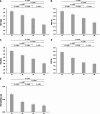The relationship between the triglyceride-glucose index and lung function in healthy individuals: a cross-sectional study of 89,809 participants from Kangbuk Samsung health study
- PMID: 40783755
- PMCID: PMC12335109
- DOI: 10.1186/s12890-025-03869-6
The relationship between the triglyceride-glucose index and lung function in healthy individuals: a cross-sectional study of 89,809 participants from Kangbuk Samsung health study
Abstract
Background: The triglyceride-glucose index (TyG) has emerged as a reliable proxy for insulin resistance and metabolic dysfunction, showing associations with various health outcomes. While the relationship between metabolic health and respiratory function has been established, the association between TyG and lung function remains unclear, particularly in Asian populations. Therefore, we investigated whether TyG is associated with decreased lung function in a large sample of healthy Koreans.
Methods: We analyzed data from 89,809 healthy Korean adults (46,739 men, mean age: 38.5 years) who underwent health examinations in 2019, stratifying participants into quartiles based on their TyG index. Lung function impairment was defined using the lower limit of normal (LLN) derived from spirometric values at the fifth percentile of our population. We calculated adjusted odds ratios (aORs) and 95% confidence intervals (CIs) for lung function impairment, using the lowest TyG quartile as the reference group.
Results: Mean TyG index was 8.34 ± 0.57. Subjects in the highest TyG quartile exhibited the lowest predicted forced expiratory volume in one second (FEV1%) and forced vital capacity (FVC%) after adjusting for covariates (P < 0.001). Also, FEV1(L) /FVC(L) ratio significantly differ among the four quartiles (P < 0.001). Compared to the lowest quartile (Q1), the aORs with 95% CI for FEV1% below the LLN across increasing quartiles (Q2 to Q4) were 1.150 (1.002-1.320), 1.272 (1.103-1.466), and 1.535 (1.310-1.799), respectively. For FVC% below the LLN, aORs were 1.233 (1.065-1.428), 1.334 (1.159-1.536), and 1.745 (1.506-2.021), respectively. Both trends were statistically significant (all P for trend < 0.001). In contrast, the aORs for FEV1/FVC below the LLN showed no significant differences among groups (P for trend = 0.186).
Conclusions: We found a significant association between higher TyG index values and decreased lung function in a large sample of healthy Koreans. Longitudinal studies are needed to establish causality and explore the long-term implications of this relationship on respiratory health.
Keywords: Healthy population; Insulin resistance; Lung function; Spirometry; Triglyceride-glucose index.
© 2025. The Author(s).
Conflict of interest statement
Declarations. Ethics approval and consent to participate: The study was approved by the Institutional Review Board of Kangbuk Samsung Hospital (KBSMC 2024-01-038), which waived the requirement for informed consent owing to the use of de-identified data for analysis purposes. This study complied with the 1975 Declaration of Helsinki and its later amendments and followed the Strengthening the Reporting of Observational Studies in Epidemiology (STROBE) reporting guidelines. Consent for publication: Not applicable. Competing interests: The authors declare no competing interests.
Figures



Similar articles
-
Associations of the Neutrophil-to-Lymphocyte Ratio(NLR), Triglyceride-Glucose Index (TyG), and TyG-derived indices with vitality decline in older adults in China: a study within the Integrated Care for Older People (ICOPE) framework.Lipids Health Dis. 2025 Jul 30;24(1):256. doi: 10.1186/s12944-025-02671-x. Lipids Health Dis. 2025. PMID: 40739643 Free PMC article.
-
Association between insulin resistance indices and outcomes in patients with heart failure with preserved ejection fraction.Cardiovasc Diabetol. 2025 Jan 22;24(1):32. doi: 10.1186/s12933-025-02595-x. Cardiovasc Diabetol. 2025. PMID: 39844150 Free PMC article.
-
Lung Function Trajectory Using Race-Specific vs Race-Neutral Global Lung Function Initiative Coefficients.JAMA Netw Open. 2025 Apr 1;8(4):e257304. doi: 10.1001/jamanetworkopen.2025.7304. JAMA Netw Open. 2025. PMID: 40279124 Free PMC article.
-
Intravenous antibiotics for pulmonary exacerbations in people with cystic fibrosis.Cochrane Database Syst Rev. 2025 Jan 20;1(1):CD009730. doi: 10.1002/14651858.CD009730.pub3. Cochrane Database Syst Rev. 2025. PMID: 39831540
-
Does diabetes status modify the association between the triglyceride-glucose index and major adverse cardiovascular events in patients with coronary heart disease? A systematic review and meta-analysis of longitudinal cohort studies.Cardiovasc Diabetol. 2025 Aug 4;24(1):317. doi: 10.1186/s12933-025-02890-7. Cardiovasc Diabetol. 2025. PMID: 40760488 Free PMC article.
References
-
- Fang NN, Wang ZH, Li SH, Ge YY, Liu X, Sui DX. Pulmonary function in metabolic syndrome: A Meta-Analysis. Metab Syndr Relat Disord. 2022;20:606–17. - PubMed
MeSH terms
Substances
LinkOut - more resources
Full Text Sources
Medical

